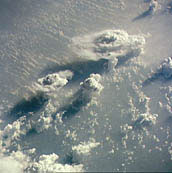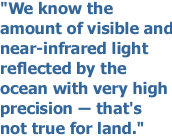

 |
by Carol Smith July 17, 2000 |
||
|
Clouds play a significant role in the Earth's climate. These swirling masses act as gatekeepers for the flow of radiation between the sun and the Earth and influence climate by reflecting and absorbing energy from the sun. Understanding the complex interplay between clouds and radiation is critical for developing general circulation models that simulate the global climate.
|
 Cloud cover over Zaire. (Image courtesy of JSC Digital Image Collection) 
 Clouds over the Pacific. (Image courtesy of JSC Digital Image Collection) For more information, visit the Langley Atmospheric Sciences Data Center DAAC and the National Center for Atmospheric Research (NCAR). (A new browser window will open.) |
Recent studies have produced conflicting conclusions of how accurately general circulation models represent one aspect of this interplay, the amount of solar radiation clouds absorb. Some investigations suggest that clouds absorb more near-infrared radiation than models predict. Other studies indicate that this enhanced absorption occurs only in clouds over tropical regions. Yet another group of studies suggest that cloud type or season may contribute to an increased absorption of near-infrared radiation.
To investigate whether or not clouds absorb more sunlight than models predict, some investigators compare model calculations to aircraft measurements of reflected sunlight. But aircraft measurements are limited in their geographic scope. "I wanted to scale this investigation to the entire globe," said William Collins, a climate scientist at the National Center for Atmospheric Research. "I realized that there were observations made on the Nimbus class of platforms, specifically Nimbus-7, that would be ideal for this kind of study." Collins divides his work at NCAR between the Climate and Global Dynamics Division and the Mesoscale and Microscale Meteorology Division. Collins compared the Nimbus-7 satellite observations of visible and near-infrared radiation reflected by the oceans and atmosphere with a general circulation model (GCM). His goal was to determine whether there were any discrepancies between the model and the observations under cloudy skies. The radiation data sets from the Langley DAAC provided Collins nine years of global observations collected from 1979 to 1987. Information included data from one wide-field-of-view radiometer that measured reflected sunlight over all wavelengths, both visible and near-infrared, while a second wide-field-of-view radiometer measured the reflected sunlight in near-infrared wavelengths. By subtracting the near-infrared from the broadband, Collins partitioned the radiation reflected from the Earth between near-infrared and visible. The Nimbus-7 cloud matrix data set provided daily and monthly mean distributions of cloud amount and cloud type. Collins modified the NCAR Community Climate Model to simulate the Nimbus-7 radiometers, and produced a set of model calculations he could compare with the satellite observations. He found that under clear sky conditions over oceans, the model and the satellite partitioning of radiation between visible and near infrared were statistically identical. When he compared his model calculations to the satellite observations of cloudy skies, he found a statistically significant difference, which he labeled a "cloudy sky anomaly." (Here, the term "cloudy sky anomaly" refers to the difference between model data and actual measurements of how clouds reflect radiant energy). "I never saw any conditions where the cloudy sky anomaly went away," Collins said. His findings are similar to those of previous aircraft studies, but Collins had nearly a decade of data as opposed to a few hours of aircraft observations. His data were also global in coverage, extending from 50 degrees North to 50 degrees South over the Earth's oceans. Collins restricted his study to the middle latitudes and the tropics to avoid the complex albedo of ice regions. He also limited his observations to the atmosphere over oceans. "The reason I confined myself to oceans is that we know the amount of visible and near-infrared light reflected by the ocean with very high precision, that's not true for land," Collins said. The anomaly occurred in the presence of all cloud types regardless of latitude or time of year. Having such a large data set allowed Collins the luxury of partitioning the data in many ways. "I split the data by cloud altitude, low medium and high, just to make sure that the anomaly showed for low clouds, which are primarily liquid clouds, and high clouds, which are primarily ice clouds," Collins said. Collins also used International Satellite Cloud Climatology Project (ISCCP) data to examine whether errors in the cloud properties, population, and distribution simulated by the NCAR general circulation model could explain the discrepancy between Nimbus-7 data and the model. ISCCP C and D1 series data sets provide descriptions of cloud properties around the globe every three hours and information on the concurrent state of the atmosphere. "What ISCCP provides is the best set of global long-term cloud property retrievals and global atmospheric properties that are available," Collins said. The visible and near-infrared reflectance values calculated from ISCCP reproduced the spectral flux anomalies found with the general circualtion model. "I think the significance of this study is it provides strong backing for the point of view that there is an anomaly under cloudy conditions everywhere we look, whenever we look. There does not appear to be an anomaly under clear sky conditions," Collins said. His calculations treated three-dimensional clouds as though they were plane-parallel. To address whether this introduced a significant bias, he relied on the work of a number of researchers with detailed three-dimensional radiative-transfer calculations on cloud fields. "In all of those cases it was clear that three-dimensional radiative transfer made very little difference in this partitioning. So the fact that I left out the interaction of radiation with the three dimensional structure of clouds is not biasing our results," Collins said. Collins sees an urgency to using the 20-year old Nimbus-7 data set. "The computers that wrote it are no longer around — they've been dismantled. In some cases, the data are in a format that is becoming unreadable. It's important to get these data read before it becomes completely unusable," Collins said. His study demonstrates the value of flying spectral instruments like those aboard Nimbus-7, and he sees research possibilities for such data beyond studying cloud absorption. "I think if we can start extending spectral measurements on new classes of spacecraft it would be tremendously advantageous," Collins said. Collecting spectral measurements onboard future satellites could be helpful in understanding how aerosols affect Earth's climate by absorbing or reflecting radiation, he said. "Having this kind of spectral information would allow us to figure out where in the spectrum the aerosols are having the biggest effect." |
|